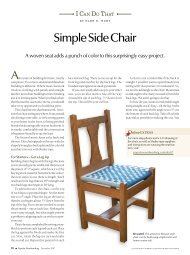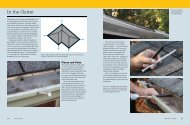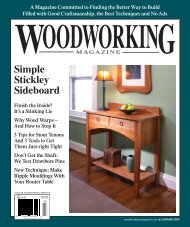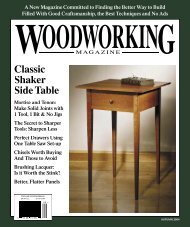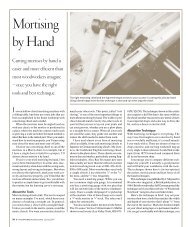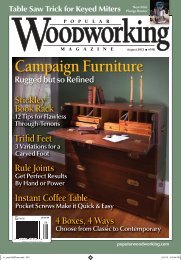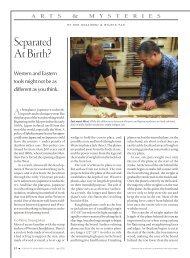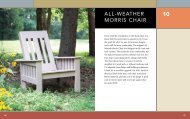Classic Shaker Side Table - Popular Woodworking Magazine
Classic Shaker Side Table - Popular Woodworking Magazine
Classic Shaker Side Table - Popular Woodworking Magazine
You also want an ePaper? Increase the reach of your titles
YUMPU automatically turns print PDFs into web optimized ePapers that Google loves.
Drawer Primer: Sliding-lid BoxWe discovered that ourdrawer-building techniqueis an ideal method to makesturdy storage boxes.TThis simple box uses the same saw setups andrabbeting techniques for building the drawershown on page 24, and it’s good practice for buildingthe “Simple <strong>Shaker</strong> End <strong>Table</strong>” on page 16.However, there are a couple of differences.Unlike a drawer, this box has a sliding lid that’scut using the same joinery we used to make thebottom. We also added a notched piece of woodinside to organize the box’s contents (for us, it’schisels). And there is a small amount of detailinganyone can try: The lid’s bevel and thumb pull aremade with a chisel, rasp and small gouge.To make the box, first choose wood withstraight grain for the sides, front and back, andwood with nice figure for the lid. We built oursfrom a hybrid called Lyptus (see page 32). Dress(joint and plane) your lumber, then cut the partsto finished size, except for the tool holder.Cut the rabbets on your side pieces next, thencut all the grooves. These grooves capture thebox’s bottom and guide the sliding lid. Finally,cut the rabbets on your bottom and lid.Lay out the 11 ⁄ 16"-wide x1 ⁄ 4 "-deep bevel on thelid and shape it using a rasp. Once you get close toyour layout lines, finish the job with a block planeor #120-grit sandpaper and a sanding block.Lay out the location of the thumb pull on thelid. Define all the edges using a straight chisel anda gouge for the curved area. Chop out the straightsection with a chisel and use the gouge to removethe waste. Hand plane or sand all the parts. If youwish to make a tool holder, do so now. To makethe slots for our chisels, we drilled five evenlyspaced 1 ⁄ 2 " holes, then cut out the remaining materialwith a hand saw or a band saw.Dry assemble the box. Once satisfied, glue thesides to the front and back. The bottom floats inits groove and the lid (obviously) slides. Reinforceeach joint with 5 ⁄ 8 " brad nails. We finishedour box with garnet shellac. WM— Christopher Schwarz and Kara GebhartSliding-lid BoxNO. PART SIZES (INCHES) NOTEST W L❑ 1 Front 1 ⁄ 2 2 6 7 ⁄ 81 ⁄ 4 " x 1 ⁄ 4 "groove on bottom❑ 1 Back 1 ⁄ 2 2 1 ⁄ 2 6 7 ⁄ 81 ⁄ 4 " x 1 ⁄ 4 "groove on top and bottom❑ 2 <strong>Side</strong>s 1 ⁄ 2 2 1 ⁄ 2 15 1 ⁄ 2 "-wide x 1 ⁄ 4 "-deep rabbet on ends;1 ⁄ 4 " x 1 ⁄ 4 "groove on top and bottom❑ 1 Bottom 1 ⁄ 2 6 7 ⁄ 8 14 1 ⁄ 21 ⁄ 4 " x 1 ⁄ 4 " rabbet on all sides❑ 1 Lid 1 ⁄ 2 6 7 ⁄ 8 14 3 ⁄ 41 ⁄ 4 " x 1 ⁄ 4 " rabbet on sides and back❑ 1 Tool holder 1 ⁄ 2 1 1 ⁄ 2 6 3 ⁄ 8 Varies depending on your usagePHOTO BY AL PARRISH28 ■ woodworking magazine Autumn 2004



